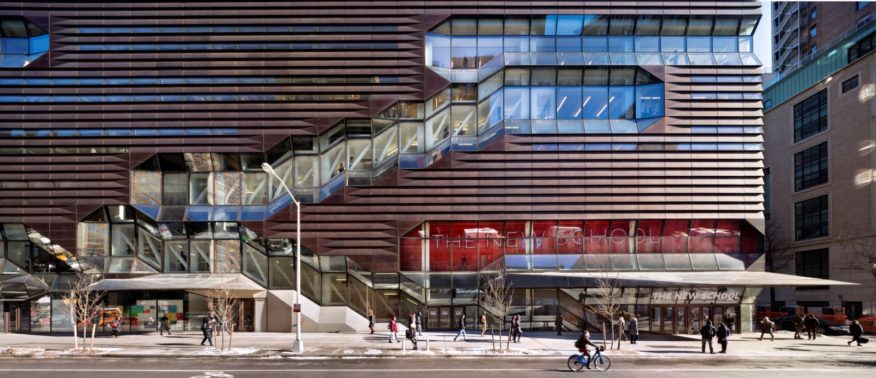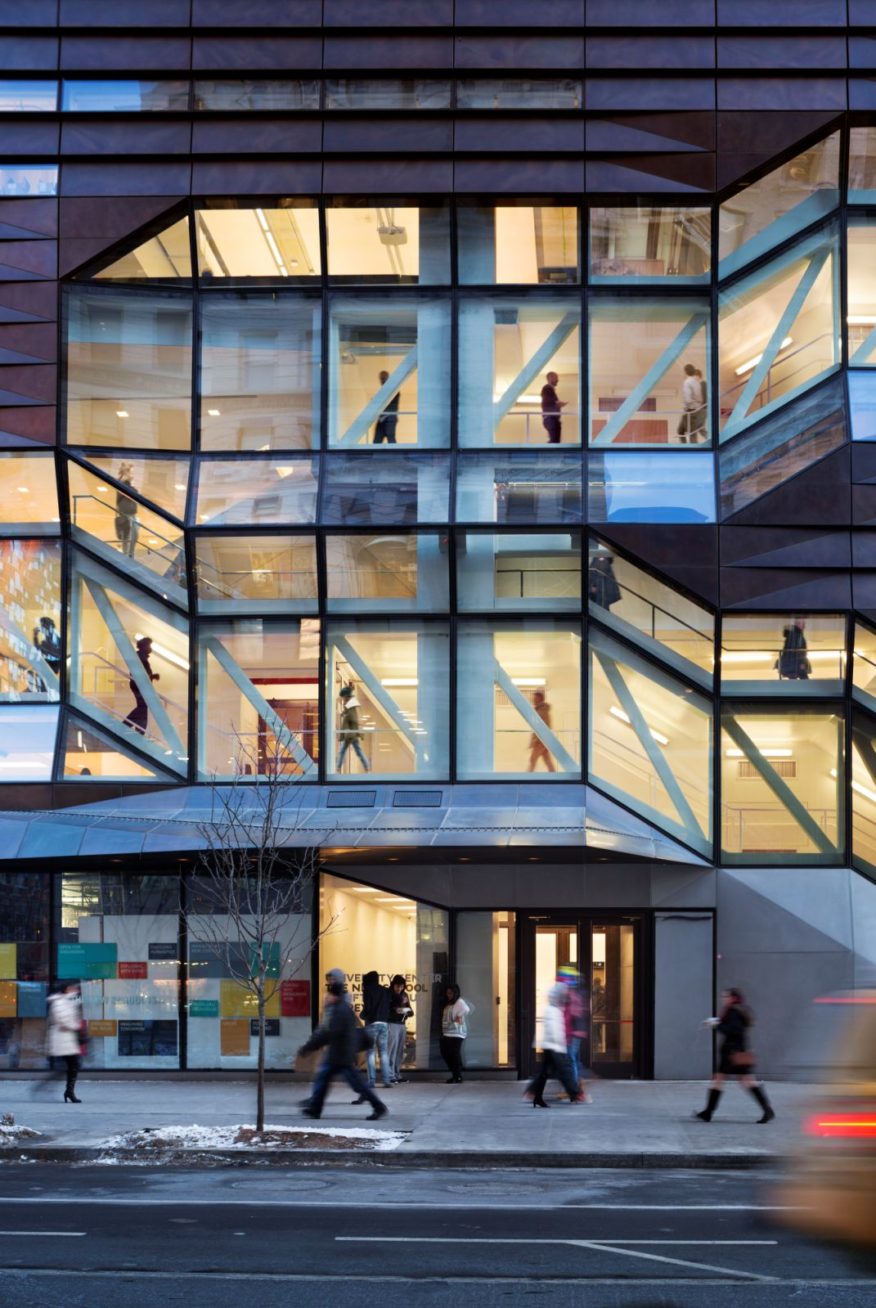
The University Center at The New School has been selected as one of 13 winners in the Urban Land Institute’s (ULI) 2017-2018 Global Awards for Excellence. The University Center adds 375,000 square feet of academic and student space to The New School’s Greenwich Village campus. The 16-story center houses design studios, laboratories, interdisciplinary classrooms, the main university library, a nine-floor student residence, an 800-seat auditorium, a café, and flexible academic and social spaces for student activity.

Conceived as a campus within a building, the University Center transforms the traditional university environment. Rather than compartmentalize learning, living, dining, and socializing spaces, these functions are situated in a vertical configuration, creating strategic adjacencies and heightening the university’s commitment to interdisciplinary learning. This innovative interior organization is expressed in the exterior of the building. Tightly woven, purpose-built spaces clad in handfinished brass shingles contrast with the open connective tissue of the stairs and quads visible through a glazed skin.

New Kind of Urban Campus
With its 230,000-square-foot, seven-story campus center (located in the building’s base) and 130,000-square-foot residential tower, the University Center reimagines the organizing elements of a traditional campus, from quads to classrooms and living quarters. Academic spaces are flexible and easily adaptable, and can be renovated or reconfigured with minimal impact on power, data, or lighting to meet changing needs. Raw finishes and an exposed mechanical system further ensure flexibility in the academic spaces.

Pathways to Discussion and Debate
The University Center’s system of double stairways plays a critical role in the life of the building; it works in conjunction with skip-stop elevators to move large numbers of students vertically through the building. Stacked one above the other, the fire stair is designed for quick circulation, while the broader, open “communicating stair” allows for travel between floors at a more leisurely pace.

Circulation paths that weave vertically, horizontally and diagonally through the building lead into and activate sky quads—interactive spaces that also orient users due to their adjacency to stairways and corridors. These interactive spaces include student lounge areas, student resource centers with adjacent meeting rooms, study areas, cafés, and pin up spaces for design studios.

To avoid crowded conditions and delays during class-change times in this vertical campus, peak elevator demand is mitigated through the combination of the intuitive system of stairways and a skip-stop elevator system. During peak times, the elevators stop at floors one, four, and six, and stairs are utilized to access the intermediate floors, while at off-peak times, the elevators stop at all floors.

A Commitment to Sustainability and Energy Efficiency
Designed to meet LEED Gold certification from the US Green Building Council, the University Center sets the New York City standard for green technology and building practices with super-efficient LED lights, occupancy sensors, a 265-kilowatt cogeneration plant, and sustainably sourced materials. Envisioned as a model of energy efficiency, carbon reduction, and sustainability, the building anticipates 31 percent energy savings over a code-compliant school.

The envelope of the building is limited to 35 percent glass, which decreases solar heat gain while optimizing interior daylighting. The shingled cladding shades the windows up to 20 percent during daylight hours. An ice-storage system, located in the second basement, uses electricity from the power grid during off-peak times to freeze water in a series of chambers; the ice melts during the day, reducing consumption during peak times. Heat recovery wheels recover heat from exhaust air and help heat supply air, saving energy.

A green roof, funded in part by the New York City Department of Environmental Protection, mitigates the heat-island effect, as well as storm-water runoff, capturing water for both grayand black-water treatment facilities in the building. Waterless urinals contribute to potable-water conservation. Composting is employed with an in-vessel composter in the cafeteria. The building serves as a living element of the curriculum, providing on-site training to the next generation of green leaders to students in environmental studies, sustainability management, and urban design.

Student Resources
A co-ed residential tower for more than 600 students occupies floors 8-16 of the University Center. An amenity space on the lower level is accessible only by residents and consists of a large common room, art studios, an exercise facility with gym equipment, soundproof music practice rooms, a study hall, bicycle storage area, mailroom, and laundry room. The University Center has three dining areas: a 280-seat cafeteria on the second floor, an 80-seat library café on the seventh floor, and a 60-seat event café on the lower level off the entrance lobby and auditorium.
- Location: New York City, USA
- Architect: Skidmore, Owings & Merrill
- Project Team: Roger Duffy, Mark Regulinski, Chris McCready, Jon Cicconi, Colin Koop, Angelo Arzano, Kimberly Garcia
- Residential Architect: SLCE Architects
- Construction Manager: Tishman
- MEP Engineer: Cosentini Associates
- Structural Engineer: DeSimone Consulting Engineers
- Civil Engineer: Langan Environmental & Engineering Services
- Lighting: Brandston Partnership
- LEED Consultant: Buro Happold
- NYSERDA Consultant: ADS Engineers
- IT/AV/Security: Shen Milson Wilke
- Vertical Transportation: Van Deusen Associates
- Commissioning: Fulcrum
- Blackwater System: Alliance Environmental
- Energy Modeling: Buro Happold
- Acoustics: Cerami Associates
- Food Service: Cini Little
- Facade Maintenance: Entek
- Theater: Fisher Dachs Associates
- Code Consulting & Expeditor: Milrose
- Signage: Integral Reudi Baur Paris
- Schedule & Cost Management: ProjectConsult
- Developer: The Durst Organization
- Owner: The New School
- Project Area: 370,000 ft2
- Photographs: James Ewing, Courtesy of SOM

